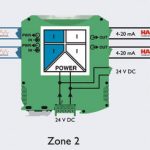The interfaces designed for explosion protection in conformity with intrinsic safety requirements are an important aspect when automating process plants containing hazardous areas. As part of the continuous expansion of its MACX Ex product line, Phoenix Contact has developed Ex-i isolating amplifier functions as well as Ex-i repeater power supplies that allow two Hart-enabled 4…20 mA transducers to be operated simultaneously in these areas.
Author Heinrich Käuper Analogue Ex Product Manager, Phoenix Contact Electronics
Process variables such as pressure, temperature, flow, humidity and pH are detected in the hazardous area using intrinsically safe transducers and then converted into electrical signals. Process automation is dominated by the 4…20 mA current signal standardised in IEC 60381-1. In addition to advantages such as low sensitivity to spurious signals and minimal errors due to cable resistance, the 4…20 mA current signal – also referred to as the live zero – allows the measuring circuit to be monitored for cable interruptions or short circuits as well as for threshold violations. If the digital Hart protocol is modulated onto the analogue 4…20 mA signal so that it is electrically neutral, threshold or diagnostic values, information such as the calibration status or the status of intelligent field devices and the actual measured value can likewise be integrated reaction-free into the process control system and remote calibrations executed.
As a result of this, the diagnostic advantages familiar from digital signal processing via fieldbus systems can be combined with the benefits of traditional 4…20 mA technology. This explains why bi-directional data transmission using the Hart protocol is increasingly popular in the process industry. Most analogue actuators and sensors in the market today are Hart-enabled, with more and more of these units available as two-wire versions if they incorporate 4…20 mA technology or are used to measure flow.
Up to 45 % less space
The MACX MCR-EX-SL-RPSS-2I-2I Ex-i repeater power supply from Phoenix Contact is designed for simultaneous and electrically isolated operation of two Hart-enabled 4…20 mA transducers in the hazardous area. With an overall width of 12.5 mm, this module requires only 6.2 mm per measuring circuit on the mounting rail, making it one of the most compact Ex-i repeater power supplies currently available in the market. This saves valuable space, particularly in applications with a large number of measuring points.
Due to the continuously upgraded circuit technology, the MACX MCR-EX-SL-RPSS-2I-2I stands out, as did the single-channel repeater power supply introduced in 2008, with its high transmitter supply voltage of at least 16 V, bi-directional transmission of the Hart protocol and high signal quality with a transmission error rate typically below 0.05 %. Its compact design is made possible by the low power loss, which is usually less than 1.2 W, or 0.6 W per channel. As is the case with all devices in the Ex-i series, the MACX Ex-i isolators were developed and certified for use in safety-instrumented applications in compliance with IEC 61508. All MACX MCR-EX-SL-RPSS-2I-2I repeater power supplies – even the single-channel version (1oo1) – achieve SIL 3. The required test cycles can be extended for the dual-channel version (1oo2).
Cable fault transparency
Sensors built into a plant or system which is situated in a hazardous area, such as contact-based transmitters and proximity switches that report positions or speed impulses, are implemented as binary devices. Ex-i isolation amplifiers are designed to transmit this information using a Namur signal according to DIN EN 60947-5-6. The two current levels (I< 1.2 mA and I> 2.1 mA) correspond to logical 0 and logical 1. The information is transmitted to the controller with Ex-i and electrical isolation via relays or transistor outputs. Unlike analogue 4…20 mA technology, the cables can be monitored using traditional Ex-i isolation amplifiers for binary sensors; however, this has certain disadvantages and is associated with additional time and effort.
If the field wiring needs to be monitored for errors, the Ex-i isolation amplifiers can be configured so that the output relay opens, or the transistor output is de-energised (disabled), in the event of a cable interruption or short circuit. However, it is now no longer possible to differentiate between switching and error states. The isolation amplifiers in the MACX Analogue Ex range therefore permit group error logging using a power and error module.
In the case of models with two outputs per channel, errors in the field wiring can be transmitted separately via the measuring circuit’s second output. Unfortunately, this calls for additional work on the part of the user, as twice as much wiring is required and there are twice as many digital input cards in the controller. Phoenix Contact offers the MACX MCR-EX-SL-NAM-NAM, a module that communicates the signal and error message via a two-wire solution, for this reason. With this objective in mind, the new isolation amplifier replicates the Namur signal on the output side, so that it can simultaneously transmit the switching signal and the cable fault message from the input circuit. As soon as a cable interruption or short circuit occurs, the output has high impedance (> 100 k Ω) and is thus clearly recognised and classified as an error by the downstream controller. The only requirement is a Namur-enabled digital input card at the controller level, but this is meanwhile available for most control systems and already used in numerous applications.
Certified for all Ex zones and gas groups
In addition to the devices described here, the MACX Analogue Ex-SL Ex-i isolator series includes a full range of Ex-i supply, input and output isolation amplifiers, Namur isolation amplifiers, valve control modules and transducers. Thanks to the compact overall width of only 12.5 mm for all single and dual-channel versions, up to 45 % less space is required compared to other solutions currently available in the market. All devices are certified according to the latest Atex and IEC Ex standards and marked Ex II(1)G [Ex ia Ga]IIC and Ex II (1) D [Ex ia Da]IIIC for Ex-i circuits up to Zone 0 (gas) or Zone 20 (dust), making them suitable for use in all Ex zones and gas groups. Furthermore, they can be installed in Zone 2 according to explosion protection type n, which is an advantage, for example, in connection with distributed automation concepts.
Hart multiplex connection
Phoenix Contact has developed a termination carrier for applications where a large number of signals have to be processed. It connects MACX Analogue isolators easily and error-free to the input and output cards of the automation systems via pre-assembled system wiring. Solutions for integrating process information from the Hart protocol are also available in separate engineering and management systems; they combine the MACX MCR-S-MUX Hart multiplexer and the termination carrier versions offered for the bi-directional, Hart-enabled input, supply and output isolation amplifiers.
cpp-net.com/0314427
Share:








